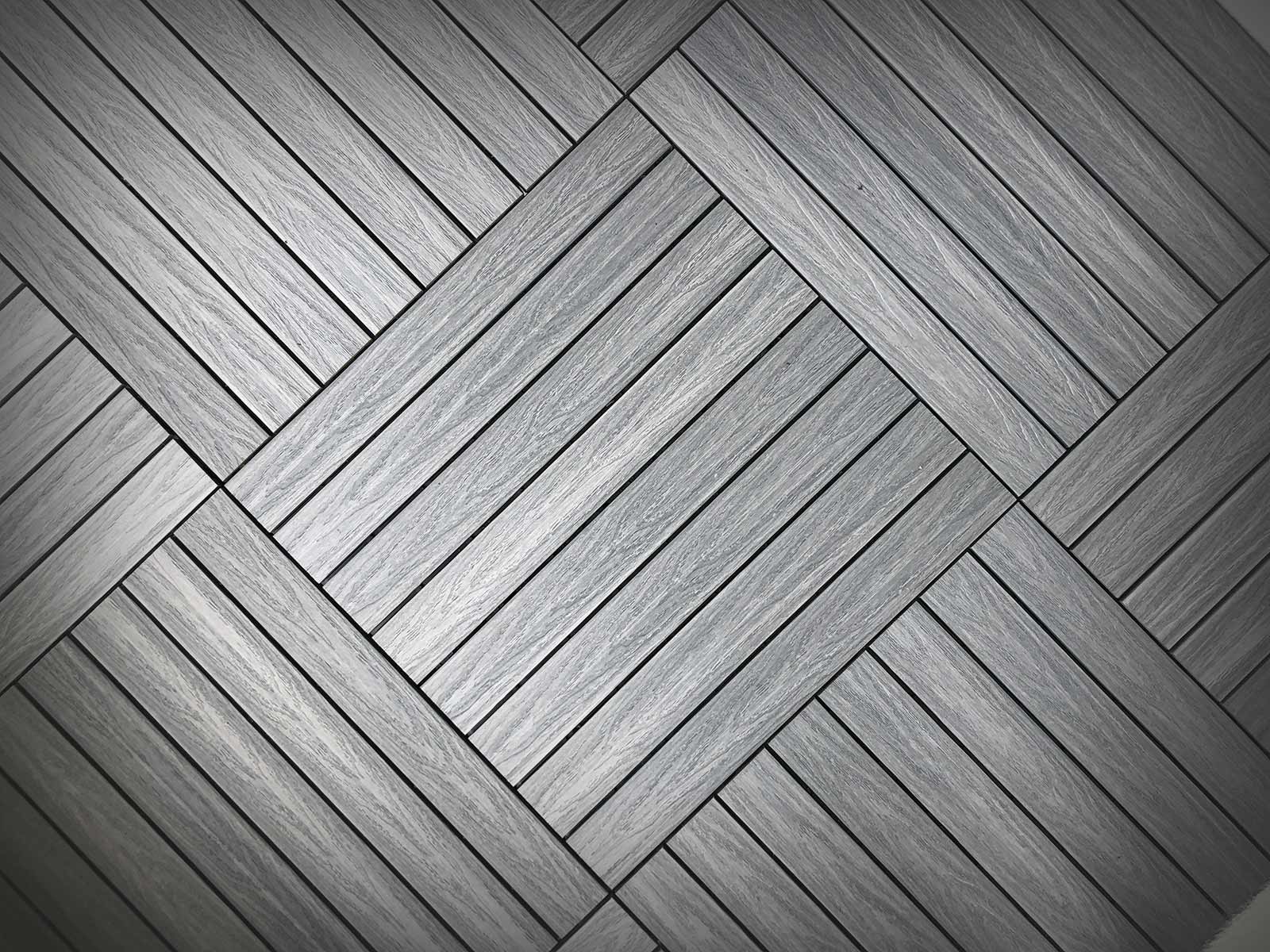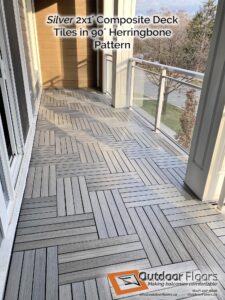Frequently Asked Questions
Balcony Flooring FAQ with informative answers on outdoor flooring deck tiles, specifically wood-plastic composites. As professional balcony flooring installers with personality and heart, we care about what we do and it shows. Feel free to contact us for any more questions. We love to chat!
- We love what we do
- We live in condos too, and have our products installed on our balconies
- Our composites, by NewTechWood, are the best on the market because of superior durability and stunning visual appeal
- Home consultations are done by an experienced installer, not a salesperson
Aside from the fact it looks awesome, balcony flooring improves the overall aesthetic of your residence. Outdoor flooring also expands living space and adds property value.
Composite Deck Tile Installation: Average pricing is $18 to $23/ft.²
These balcony flooring prices include deck tile supply with custom installation and 10-year warranty. Discounts are available for larger balconies. However, we must charge a minimum for balconies under 100 ft.².
We have sales and deals all the time so just let us know if you’re on a limited budget.
Unfortunately, we sell the product solely for large orders (over 1000 sqft). Other than that, our pricing includes supply and installation together.
Balcony floor installation is not so simple because there’s usually some sort of complexity. To look professional, deck tiles need to be cut so to properly cover the concrete balcony floor. Other obstacles include balcony railing posts, glass divider posts and electrical outlets. There’s also the risk of tile pieces lifting in high winds and becoming dangerous projectiles. We know how to get around that.
Capped wood-plastic composites (WPC) are the most durable of outdoor flooring products available. They withstand the harsh Toronto climate and are easily cleaned despite coverage in snow, dirt or debris. The key is the semigloss cap (see below for more). Stunning visual appeal and lack of fading, scuff marks and mildew also distinguish WPCs from plastics and cheap Acacia wood tiles. To learn more about composite decking tiles, check out our blog article.
WPC outdoor deck tiles are made from a mixture of recycled wood and plastic products. When melted down and shaped into slats on plastic bases, they form a product much stronger than the sum of its parts.
Composite deck tiles are the cat’s meow of balcony flooring. This is because they look amazing, do not require sanding and staining and are incredibly durable even in the harsh Toronto climate. To learn more about the history of composites, check out our other blog article here.
 In short: The deck tile cap is a 0.5-0.7 mm protective shell conferring resistance to stains, scuffs, mould and warping (and uhh… doggy puddles).
In short: The deck tile cap is a 0.5-0.7 mm protective shell conferring resistance to stains, scuffs, mould and warping (and uhh… doggy puddles).
Early generation composite deck tiles were prone to warping because water absorbed directly into the composite slats. To overcome this, a protective glossy layer (the cap) was baked into the tiles during manufacturing. Coverage of the composite tile on all surfaces makes them impermeable to water. Moreover, this glossy cap resists stains, scuff marks, mould and fading from UV light. Amazing stuff really.
Buyer beware of matte-finish caps. It has been our experience such tiles are prone to marking, especially scuff marks as well as warping. Thus, not all deck tile caps are equal.
Simply send us an email with the following:
- Type of outdoor space (balcony, terrace, patio)
- Approximate or actual size (in feet and inches preferably)
- Include a few photos
From there we can generate a rough quote and answer any questions or concerns you have.
This is the mackdaddy of all flooring patterns because it breaks up a rectangular space by creating angles in a way that is eye-catching and borderline brain teasing.
Please let us know as early as possible if you’d like a separate quote for this pattern.
Although it costs more because of higher wastage and labour, it’s worth it for certain applications (i.e., not preferable on a “busy” balcony with lots of stuff on it). Herringbone at 90-degrees is equally beautiful with it’s zigs and zags but is also not ideal on a busy balcon
To see more herringbone patterns, check out our Project Pages.
Metropolitan Toronto and GTA (Greater Toronto Area) mainly, but also as far as:
- Barrie, ON
- Kingston, ON
- London, ON
- Niagara Falls, ON
If further, please let us know either way. We’re easy going people who like travelling. 🙂
We operate on a first-come, first served basis. If you are comfortable with the quote, the next step is to reserve your tiles by remitting a deposit for 50% of the grand total, preferably by email money transfer. You will receive a receipt ASAP. No messing around.
Usually within 1-2 weeks but sometimes longer during our busy season (May through July).
Outdoor Floors offers a variety of tiles and patterns. Flooring patterns include:
- simple linear
- staggered linear (like a brick wall)
- parquet (checkerboard) in 1×1′, 2×2′ and larger
- herringbone at 90°
- herringbone at 45° (this is the “Mack Daddy” of all balcony flooring patterns)
Our preferred method is by email money transfer to our main e-mail account (payment@outdoorfloors.ca). We also accept cash and credit cards but charge a 3% fee. Please note, we do not accept “cash” payments in which HST is avoided. All is above board with us. We run an honest business because we’re honest people who try to minimize stress, not create it.
- 10-year manufacturer’s warranty
- 10-year workmanship warranty
- Outdoor Floor’s solutions fits within strata and condo regulations because the outdoor floor:
- Is not attached nor is a permanent structure in any way
- Does not contribute to water pooling because it allows water to drain through the plastic tile bases and simply washes away
- Facilitates airflow ventilation through the tile slats
- Do not put the building envelope at risk in any way
- If window washer’s mounts need to be accessed, our interlocking tiles can be simply detached and lifted up and out. If the connections are tight fitting, a screwdriver helps to disconnect the tiles.
- Yes, but the Ontario building code require two major things:
- Railing height must be 42″ or higher. So, with our 1″ floors, the railing height needs to be 43″ or higher.
- The deck tile floor must not be fastened to the underlying concrete or building.
Please keep in mind our floors are akin to an outdoor area rug. Most condo boards do not require approval for such removable items.
We come to you instead! It’s truly best to see the tiles on your own outdoor space to get a “feel” for the deck tile colours and compare with both the brickwork and accents of your building or home.
*Most of the time it’s best to go over the rough quote first to ensure the proposed work is within your budget.
A major benefit of WPC composite deck tiles (wood-plastic composites) is they don’t fade under sunlight like wood products. No need for sanding and staining! The only thing is to clean them once or twice a year using a:
- Vacuum (regular house vacuum or ShopVac)
- Spray mop or similar
For resistant markings, a good ol’ bucket of warm, soapy water and scrub brush will do the trick.
Yes. They are vulnerable in two specific situations:
- Heating up to uncomfortable levels under midday summer sun. (Solution: roll out an area rug)
- Staining from oily substances (Solution: Keep an outdoor mat under your BBQ and clean spills ASAP with soap and water)
Yes, absolutely. Lots of cool info in these documents for nerds like us. For instance, the fire rating for our deck tiles is “Class B”, which is acceptable by building standards.
- NewTechWood MSDS (safety)
- NewTechWood Specifications- NewTechWood
- NewTechWood Care and Cleaning Instructions
- NewTechWood Warranty
Most of the time it will take between 4 and 6 hours.
YES! We install synthetic grass (formerly Astroturf) all the time on balconies, porches and terraces. We usually combine it with deck tiles and other elements. We use rolls of turf rather than grass squares to avoid unsightly seam marks. Turf is placed on top of plastic bases to facilitate ventilation and water drainage.



